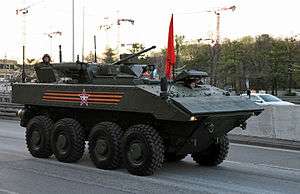Bumerang
| Bumerang | |
|---|---|
 Bumerang APC Bumerang APC | |
| Type | Armored personnel carrier |
| Place of origin | Russia |
| Specifications | |
| Weight | 25 tons |
| Crew | 3 (+9 passengers) |
|
| |
| Armor | Some form of ceramic |
Main armament |
Bumerang IFV: Bumerang-BM remote control turret with 30 mm automatic cannon 2A42, 9M133 Kornet anti-tank missiles, and PKT 7.62 mm coaxial machine gun Bumerang APC: 12.7 mm machine gun remote turret |
| Engine |
Yaroslavl Motor Plant turbocharged diesel YaMZ-780 750 hp[1] |
| Suspension | wheeled 8×8 |
Operational range | 800 km (500 mi) |
| Speed | 100 km/h (62 mph) |
The Bumerang (Russian: Бумеранг, Boomerang) is an amphibious wheeled armored personnel carrier being developed for the Russian Army.
History
In the early 1990s, the BTR-90 was developed as a replacement for the BTR-80 in the Russian Army. While it was an improvement in armament, protection, mobility, and internal space over its predecessor, it all came at the cost of greatly increased unit price. It wasn't accepted into service (except in small numbers) as the modest increase in performance wasn't seen as enough justification for its cost and complexity. Purchases of the BTR-80 stopped in 2010 and the improved BTR-82 was obtained as a stop-gap measure. In mid-2011, the Russian Ministry of Defense issued a requirement for a modular wheeled family of armored vehicles instead of buying the BTR-90. Development of a new wheeled APC is being done alongside the new and similarly armed Kurganets-25 infantry fighting vehicle.[2][3]
In November 2011, media reports said the new project had been approved. On 21 February 2012, Colonel General Alexander Postnikov said that the Russian Army would be taking the first deliveries of the Bumerang prototype in 2013. Large-scale deliveries are to begin in 2015. At least 2,000 Bumerang vehicles are to replace the BTR-80 and BTR-82/A in Russian service.[2][3][4]
The Bumerang was first seen in public (initially with its turret and cannon shrouded) during rehearsals for the 2015 Moscow Victory Day Parade.
Design

Voyenno-Promyshlennaya Kompaniya, the company making the Bumerang, claims it “will be nothing like any of the modern APCs.” Many details about its design have not been released, but it is known that the vehicle will be amphibious and be able to negotiate and overcome water obstacles using two waterjets. In a departure with the previous BTR series of vehicles, the engine will be located in the front instead of the rear. Engine location was a significant drawback of BTR vehicles, where soldiers had to exit the vehicles through cramped side doors. The Bumerang has rear doors and roof hatches for troop entry and exit. It will likely have a crew of three consisting of the driver, gunner, and commander and hold seven troops. Protection will come from ceramic armor and technologies to prevent shell splinters. Like BTRs, the Bumerang will be an 8×8 wheeled vehicle, and will be equipped with a 750 hp turbocharged diesel engine. Several components and subsystems will be interchangeable between the Bumerang APC and Kurganets-25 IFV, and both vehicles will be powered by the same engine.[2][3][5] There are two versions of the Bumerang 8×8 vehicle: the K-16 armored personnel carrier (APC), lightly armed with a 12.7 mm machine gun in a small remote turret; and the K-17 infantry fighting vehicle (IFV), heavily armed with the Bumerang-BM RWS with a 30 mm cannon and Kornet-EM anti-tank missiles.[6]
Variants
The Bumerang is referred to as "a combat wheeled vehicle" because it will serve several different roles, similar to America's Strykers. Other vehicle platform variations will fulfill different roles in addition to armored transport, including as an armored ambulance, command post vehicle, reconnaissance vehicle, anti-tank missile carrier, air defense missile launcher, fire support vehicle, and mortar carrier.[2] Further versions could include a light tank[5] and a self-propelled gun.[4]
See also
- Bumerang-BM - Epoch remote control turret
- Kurganets-25
- T-15 Armata
- Typhoon (AFV family)
External links
| Wikimedia Commons has media related to Bumerang. |
References
- ↑ http://vestnik-rm.ru/news-4-17354.htm
- 1 2 3 4 Bumerang - Military-Today.com
- 1 2 3 Bumerang [Boomerang] - Globalsecurity.org
- 1 2 Russian Army to Get Boomerangs in 2013 - En.Ria.ru, 21 February 2012
- 1 2 First prototype of the Russian wheeled armoured personnel carrier Boomerang will be ready for 2013 - Armyrecognition.com, 7 July 2012
- ↑ New version of Russian K-16 and K-17 Bumerang were unveiled during military parade in Smolino - Armyrecognition.com, 2 August 2016